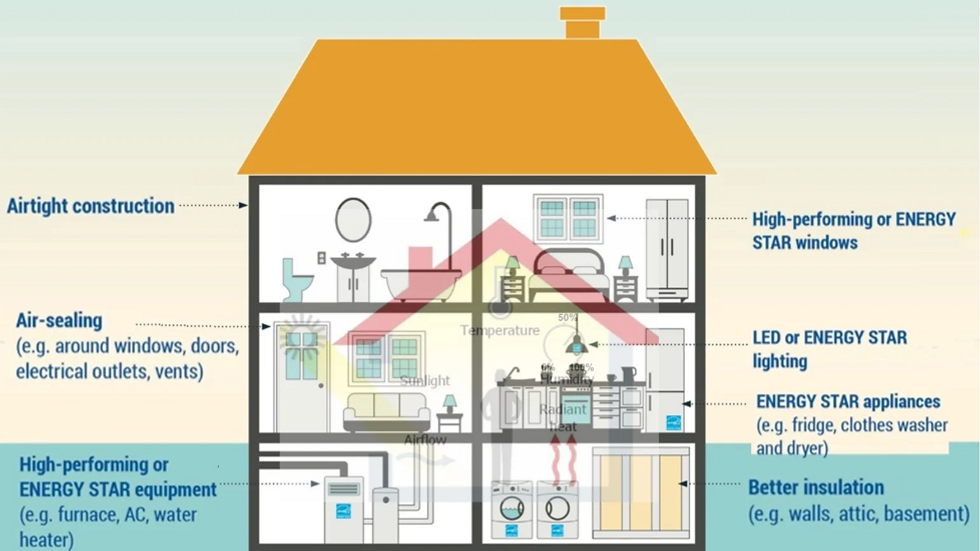5 Sneaky Building Design Mistakes: Energy Saving Tips for Indian Homes
- indrsarv
- Jun 20
- 5 min read
Updated: Oct 31
"You’ve done your bit—set the AC to a reasonable temperature, switched off fans and lights when not in use, and maybe even bought energy-efficient appliances. Still wondering why your electricity bill is higher than expected—even with these basic precautions in place? The truth is, most Indian homes and buildings lose energy in ways that aren’t always visible. At SARV Sustainable, we consider it our responsibility to help you spot these silent energy leaks and design smarter, more efficient spaces right from the beginning.
In this article, we will explore five often-overlooked factors that quietly sabotage your energy efficiency, along with energy-saving tips for Indian homes supported by global research. Our climate-responsive design philosophy underpins every recommendation.

1. Air Leaks Around Doors and Windows: The Invisible Draft
The Problem
Small cracks and gaps around windows, doors, and walls might seem minor. However, they allow unwanted air in or out. This makes it harder to keep your space comfortable—a concept we call thermal control.
What the Research Says
Research indicates that invisible drafts can increase heating and cooling loads by up to 30% (Energy Efficiency Journal, 2021). A report from the National Institute of Standards and Technology mentions that improving a home’s air tightness can reduce electricity consumption by up to 9%.
SARV’s Approach
At SARV Sustainable, we view air-tightness as a core design principle. We employ smart detailing and techniques that block unwanted sun using elements like overhangs and vegetation (Passive Shading). We also use high-performance materials to reduce leakage at the source—not just patch it later.
2. Inefficient Lighting Systems: When Bright = Wasteful
The Problem
Many buildings in India still rely on outdated lighting—like tube lights and incandescent bulbs—that consume significantly more electricity than necessary. Coupled with poor planning, such as leaving lights on in empty rooms, this creates a considerable energy waste.
What the Research Says
Global studies show that switching to LED lighting can reduce lighting energy use by 50–80%. In commercial buildings, systems featuring daylight-responsive dimming can further cut energy use by 20% (Lawrence Berkeley National Lab, 2020). In tropical countries like India, which enjoy abundant natural light, these savings can be even greater.
SARV’s Perspective
At SARV Sustainable, we prioritize a daylight-first approach to lighting design. We carefully plan window placements, shading, and surface finishes to maximize natural light without producing glare or excess heat.
To complement daylight, we integrate:
Light shelves to bounce sunlight deeper into rooms
Smart zoning to illuminate only necessary areas
Motion sensors and dimmable LEDs to minimize energy use in low-usage spaces
Good lighting is not just about brightness—it’s about maintaining a thoughtful balance between natural and artificial light, comfort, and efficiency.
3. Oversized or Poorly Maintained HVAC Systems
The Problem
HVAC stands for Heating, Ventilation, and Air Conditioning. A residential HVAC system maintains home comfort by heating, cooling, and improving indoor air quality. Unfortunately, many HVAC systems are improperly sized, poorly ducted, or poorly maintained. This results in inefficiency, higher costs, and discomfort.
What the Research Says
According to ASHRAE, incorrectly sized HVAC systems can enhance energy usage by up to 30%. Duct leakage alone can lead to 20-40% energy loss in conditioned air. In India’s hot and humid regions, inefficient HVAC systems frequently cause overcooling, poor indoor air quality, and soaring energy bills—especially in commercial spaces.
SARV’s Solution
At SARV Sustainable, we start with the basics: understanding the actual thermal load of a building, i.e., how much cooling or heating is truly needed. We design appropriately.
Our HVAC-conscious approach includes:
Accurate load calculations based on room size, materials, and local climate
Thermal zoning to divide the building into independently cooled areas
Cross-ventilation planning to lessen reliance on air conditioning
Maintenance-friendly layouts to encourage regular upkeep
4. Phantom Loads: When Off Isn’t Really Off

The Problem
Even when devices appear to be switched off, many still draw power. Chargers, TVs, Wi-Fi routers, microwaves, and set-top boxes continue to consume electricity in standby mode, subtly adding to your monthly bill.
What the Research Says
The International Energy Agency reports that standby power can comprise 5–10% of total electricity use in developed countries. In urban Indian households with multiple appliances, this can lead to 3–5% of the annual energy bill—often without anyone realizing it.
SARV’s Insight
At SARV Sustainable, we design not just for major systems but for these silent leaks too. Here’s how we manage phantom loads:
Smart plugs and power strips that cut off power completely when devices aren’t in use
Master switches for specific areas, allowing users to turn off multiple devices at once
Home automation readiness to schedule or control devices remotely
User education, including handover kits that share energy-saving practices tailored for each project
Phantom loads can be easy to overlook—however, once noticed, they become simpler to regulate. That's where thoughtful design plays a critical role.
5. Poor Building Envelope Design
The Problem
If your building’s walls, roof, or floors aren’t built with the right materials or insulation, you risk losing cool air in summer or letting in excess heat. This forces your AC to work overtime, creating one of the most significant unseen causes of high energy bills in India.
What the Research Says
The World Green Building Council notes that poorly insulated buildings in hot climates may use up to 60% more cooling energy. International Passive House studies suggest that well-designed envelopes employing efficient materials and airtight construction can reduce total energy use by as much as 70%.
SARV’s Philosophy
At SARV Sustainable, we view the building envelope as your first line of defense—it’s not just a shell but a functional performance system.
We design envelopes to be:
Climate-specific: Different strategies for hot-dry, composite, or coastal zones
Material-conscious: Prioritizing local, low-carbon materials such as fly ash bricks and insulated mud blocks
High-performance: Implementing passive design tools, including:
- Cavity walls to block heat
- Ventilated facades that allow the envelope to breathe
- Roof gardens and radiant barriers to mitigate heat gain from above

The SARV Takeaway
At SARV Sustainable, we aim not only to create visually appealing spaces but also to ensure they function efficiently. Our commitment to a methodology is evidence-backed, locally informed, and globally aligned.
Our design process integrates:
Passive strategies prioritized first
Performance modeling wherever possible
Smart technology readiness
Lifecycle thinking and user education
We believe that small design decisions can culminate in significant energy savings. As India urbanizes and faces a more unpredictable climate, SARV is ready to create buildings that not only consume less but also contribute more to their environment.
Interested in a free 30-minute energy design consultation for your next project?
Reach out to us at sarv.sustainable@gmail.com—we’d love to show you what performance-first architecture can look like.


Comments